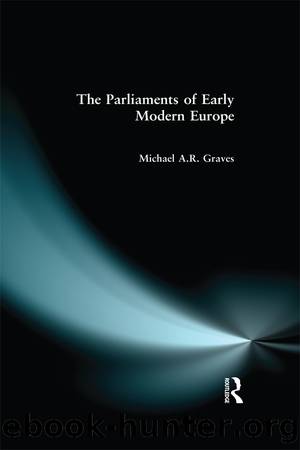The Parliaments of Early Modern Europe by M.A.R. Graves

Author:M.A.R. Graves [Graves, M.A.R.]
Language: eng
Format: epub
Tags: History, General, Europe, Germany, Modern, 17th Century, 18th Century, 16th Century
ISBN: 9781317884323
Google: 1WjJAwAAQBAJ
Publisher: Routledge
Published: 2014-06-06T16:04:16+00:00
The autocratic tendencies of early modern hereditary rulers
The institutional diversity, decentralisation and even independent jurisdictions of late medieval territories encouraged the growth of autocratic tendencies which were necessary to achieve more effective royal control. In pursuit of this end some rulers appealed to absolutist ideology. War could give a sense of urgency to the process, as it could no longer be sustained from the old royal hereditary revenues. This could enhance the bargaining position and political authority of parliaments but equally it could encourage rulers to seek alternatives. Even then, as in France when monarchs no longer called the Estates-general after 1614â15, all was not what it seems in retrospect. It was not an obstacle to royal authority which was laid to rest, but an unrewarding, timeconsuming institution which was rendered ineffective for a variety of reasons: geographical, social and cameral divisions, lack of legislative or financial powers, the absence of any working link with the more frequent provincial estates, and the hostility of other institutions, such as the Paris parlement, towards it.
The Holy Roman Empire provides more convincing evidence of estates as victims of autocratic princes. Yet even here the picture is one of contrasts. The seventeenth-century imperial diet remained an unreformed assembly which increasingly resembled a gathering of diplomats representing effectively independent principalities and cities. It met infrequently (in 1613, 1640â41, 1653â54) until 1663, when a permanent diet was established at Regensburg. This made little difference, because it was divided by religion, minority rights were protected, and it lacked the power to raise funds for effective imperial defence and administration. In any case it was the assembly of a decentralised empire in which, as a consequence of the Thirty Yearsâ War (1618â48), the princes were recognised as territorial sovereigns. As such they could ignore or reject any of the dietâs actions which impinged on that sovereignty. Weak though the diet was, neither its authority nor its existence were under threat from a powerful ruler, because the emperorâs role after the Thirty Yearsâ War was little more than that of a figurehead.
Among the estates of the German principalities, those of Wiirttemberg flourished after the war, in which the duchy had become a battleground. This was due, however, not to some kind of parliamentary triumph over the dynastic ambition and autocratic aspirations of the ruling prince. It was the consequence of the prince, Eberhard III (1633â74), whose traditional approach to government was based upon a co-operative relationship with the Landtag and a respect for its rights. This ducal policy was reinforced by the governmentâs financial dependence on the assembly. The war, which had involved heavy taxation, Habsburg military occupation, looting and the destruction of property by marauding soldiers, left a ruined economy, an empty treasury and debt which obliged Eberhard to look to the estates for assistance. So, for a variety of reasons, his reign was marked by the activity of a revitalised Landtag.29
Saxony, like Wiirttemberg, was ravaged by the Thirty Yearsâ War. It was spared the direct impact of military operations until 1630.
Download
This site does not store any files on its server. We only index and link to content provided by other sites. Please contact the content providers to delete copyright contents if any and email us, we'll remove relevant links or contents immediately.
Women and Jewish Marriage Negotiations in Early Modern Italy by Howard Tzvi Adelman(406)
Warrior King by Wilbur Smith(364)
18 real-life stories of serial killers and murderers with solved and unsolved killings from the USA, UK, Europe, and beyond. by Ben Oakley(284)
The Battle of Austerlitz by 50minutes(279)
Violence and Emotions in Early Modern Europe by Susan Broomhall;Sarah Finn;(273)
Who's Who in the Zulu War, 1879: The British by Adrian Greaves Ian Knight(270)
The American Crisis by Unknown(262)
Youth, Heroism and War Propaganda: Britain and the Young Maritime Hero, 1745â1820 by D. A. B. Ronald(237)
The Seeker by S. G. MacLean(228)
The Origins of French Absolutism, 1598-1661 by Alan James(216)
The Dutch East India Company and British East India Company: The History and Legacy of the Worldâs Most Famous Colonial Trade Companies by Charles River Editors(211)
The Traitor of Colditz by Robert Verkaik(199)
A Genius for Confusion by Richard M. Fried(197)
Invisible Worlds by Peter Marshall(197)
The Thirty Years War â Complete by Friedrich Schiller(196)
Fires of Faith by Catholic England under Mary Tudor(194)
The Slave Trade in Africa by Simon Webb;(193)
The Opium Wars: Exploring the Addiction of Empires from Beginning to End by Ramos Adrian & Compacted History(192)
Interest and Connection in the Eighteenth Century by Jacob Sider Jost(191)
